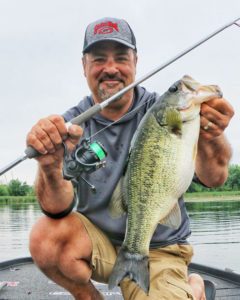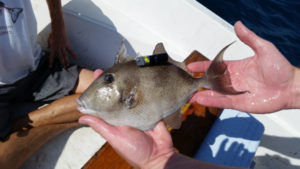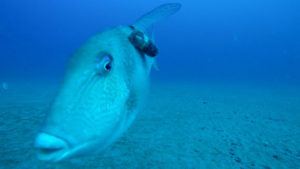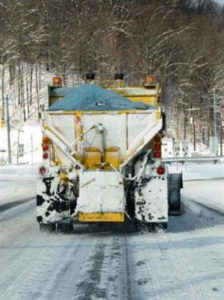Mystery of World Record Redear Solved?
by Nick Walter, Arizona Game and Fish
from The Fishing Wire
5 years after world-record redear sunfish catch, invasive quagga mussels considered a likely contributor to monster sizes of these sunfish at Lake Havasu
PHOENIX — Have the redear sunfish at Lake Havasu really gone quagga crazy?
Have these panfish that really can fill a pan, and are widely regarded as one of the better fish species to eat, found a surplus of invasive quagga mussels to munch?
A mystery remains: Redear sunfish at Havasu have been reaching world record sizes. But why, exactly?
Let’s dive into this piscatory puzzle.
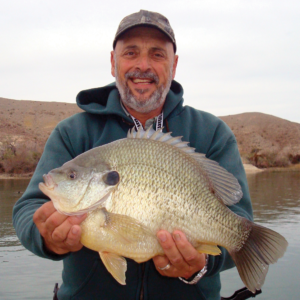
World Record Redear Sunfish – also known as shellcracker
On Feb. 16, 2014, Hector Brito caught a world-record redear sunfish from Lake Havasu.
That world-record feeling
Five years ago, “panfish” took on a new meaning.
We’re at the time of year when Lake Havasu tacked its world-record pin on the fishing map. On Feb. 16, 2014, Hector Brito caught a 17-inch, 5.78-pound world-record redear sunfish on a dropshot-rigged nightcrawler.
“I didn’t expect the record to last this long,” Brito said. “It’s amazing.”
This 45-mile fishing wonderland created by the Colorado River on the western-most strip of Arizona, adorned like a leather belt by the regal London Bridge, allows an angler to fish from the beach on the Arizona side and see the California mountains on the other. Some of those anglers said they witnessed a dramatic increase in the sizes of redear sunfish from 2009-2014 that — coincidence or not — occurred after invasive quagga mussels were first discovered in 2007 at Havasu.
In 2014, the U.S. Bureau of Reclamation (BOR) did a study about the effects of redear and bluegill on quagga populations and found these sunfish do consume quaggas. Even more, the redear reduced quagga numbers by as much as 25 percent. The experiments of the study were conducted in field enclosures of Lake Havasu, as well as in the BOR’s Boulder City, Nev. Fish Lab. See the updated report.
The Arizona Game and Fish Department can’t verify that redear sunfish, also known as “shellcrackers” because of their pharyngeal teeth (throat teeth) that allow them to crush crustaceans such as snails, are reaching unprecedented sizes due solely to quaggas as an additional food source. Other biological factors include Havasu’s food base of grass shrimp and redswamp crawdads.
Regardless, Havasu is home to some of the biggest shellcrackers on the globe.
Fish chatter: redear sunfish are “quagga crazy”
Doug Adams, a former Lake Havasu City-based fisheries biologist for the Bureau of Land Management, said he also knows that redear sunfish eat quagga mussels. At the same time, he said that in 2005 — 2 years before quagga mussels were discovered in Lake Havasu – an electroshocking of 75 sites produced redear sunfish that averaged more than 2 pounds.
“From one standpoint, there wasn’t much fishing pressure until they started catching these bigger (redear),” Adams said. “Quagga could be a good contributor to their sizes. So it’s kind of a mystery.”
A mystery it might remain.
air of big redear sunfish captured during AZGFD’s November, 2018 survey at Lake Havasu.
Ashley’s monster redear sunfish caught during April of 2017 reportedly weighed 5.02 pounds and measured 16 1/2 inches.
During AZGFD’s fall, 2016 Havasu survey, the biggest redear sunfish captured (left) was 2.5 pounds.Still, some Arizona anglers have etched their conclusion: The increasingly larger sizes of redear is a quagga-based phenomenon.
For angler Mike Taylor of Phoenix, it’s simple:
They don’t call them ‘shellcracker’ for nothing,” he said. “No quagga, then lots of quagga. Regular redears, then big redears after quagga show up … coincidence? Maybe, but I’d say increased food source equals bigger fish.
In an email to the Arizona Game and Fish Department, an anonymous angler said he has been fishing extensively for sunfish in Lake Pleasant and the Colorado River. He wrote:
And I have observed that not only do redears feed on quagga mussels, but bluegill and green sunfish do as well. After holding them in a live well for a short period of time, they will regurgitate bits of broken quagga shells until there is a layer approximately a quarter-inch thick in the bottom of the live well.
And finally, some thoughts from Brito, the record holder:
They eat a lot of quagga mussels. Everytime I fish for them, I search their stomachs and always find shells of quagga mussels.
Redear sunfishing techniques
A new world record remains possible.
“I’m sure there’s a 7-pounder out there somewhere,” said John Galbraith, owner of Bass Tackle Master in Lake Havasu.
Perhaps surprising to some, AZGFD has not received a report of a redear that’s come close to challenging the record. Brito said that since his world record, he’s caught some big ones: a 2- and 3-pound redear this year and one last year that weighed nearly 4 pounds.
Are you up for a shell-cracking quest?
Here’s some redear sunfishing tips:
Use the right rig: One of the most popular techniques for catching redear sunfish is using a dropshot rig with a nightcrawler — the same technique Brito used when catching his world record. Brito said he caught the record by the chalk cliffs, and the rig included a No. 8 gold Aberdeen hook.
Show a natural presentation: Others use worms on the bottom, without a weight or bobber, and allow the bait to lie motionless.
Expect a light bite: Redear bite gently and seem to reject baits that offer resistance such as lead weights. Sometimes, redear will simply move the bait a foot or so like an unsettled shopper.
Depth and habitat: At Havasu, when redear are not in shallow water during their typical May/June spawn, they can generally be found in 22-30 feet of water. Redear prefer vegetated areas with submerged stumps and brush with little or no flowing water.
Record fish are loners: The world record-size redears seem to break away from the schools of smaller fish. “They’re more solitary fish,” Galbraith said. “You don’t see 1-pounders with a 5-pound fish.”
Back on the dinner table, redear are widely considered excellent eating. Their diet consists of hard-shelled organisms like clams or snails, as well as insect larvae, planktonic crustaceans and other invertebrates.
Quagga mussels: an aquatic invasive species
Stocking redear as a featured sport fish in some locations is a possibility.
Yet it’s unlikely the Arizona Game and Fish Department would stock redear sunfish with the sole purpose of reducing populations of the quaggas, which also have affected Lake Mead, Lake Mohave, the Lower Colorado River below Lake Havasu to Mexico, the Central Arizona Project canal, Lake Powell, Lake Pleasant, Canyon Lake, Saguaro Lake, and Red Mountain Lake.
Quagga mussels are a poor food source for most other fish species, and drastically reduce food availability for aquatic organisms. This results in smaller catch sizes of other sportfish and native fish species. Quagga mussels may also contribute to increasing occurrences of toxic algae blooms, which can affect both humans and wildlife.
Quaggas colonize rapidly on hard surfaces and can ruin boat motors and clog water intake structures such as pipes and screens, thereby impacting pumping capabilities for power and water treatment plants.
A 2016 U.S. Bureau of Reclamation report looked at costs related to quagga mussel management on the Hoover, Parker and Davis dams along the Lower Colorado River and found more than $6 million of additional funds were spent through 2016 with an estimated $17 million of ongoing maintenance through 2020.
This results in high water and power bills for consumers.
No mystery: Havasu a fishing destination
When it comes to the smallmouth bass, largemouth bass and redear sunfish, the fishing is at its historic best. The lake continues to be ranked as one of the top places to fish for bass in the country: in 2018, Bassmaster Magazine ranked Havasu as the No. 7 best bass lake in the Western U.S.
Redear sunfish isn’t the only species thriving at Havasu. Largemouth and smallmouth bass are also swimming in luxury. Already in 2019, the average winning daily 5-fish bag weight has been around 21 pounds. Most bass-tournament anglers consider average bags weighing more than 20 pounds impressive.
Striped bass fishing also appears to be on the rise. The single-day record for the total weight of striper was set during the annual Lake Havasu Striper Derby during May of 2018: eight stripers totaled 110 pounds, a new one-day record at the 37-year-old tournament.
Robert McCulloch Sr., founder of Lake Havasu City, would probably have been proud.
At the Lake Havasu City Visitor’s Center, history exits in a binder of newspaper clippings. One of the articles, coated in a hue of rusty yellow, features a black-and-white photo with a shoreline marked by protruding finger- and T-shapes that jet into Lake Havasu. The photo of old Site 6 dominates the cover of the Lake Havasu City Herald, issued Jan. 4, 1968.
That’s how it looked when Lake Havasu City founder Robert McCulloch Sr. flew overhead. He would end up purchasing a version of the London Bridge to adorn the Havasu Channel of his city.
McCulloch could hardly have imagined how big the redear sunfish have become – nearly 6 pounds, with potential for more.
The world-record redear caught in February was not even a spawning fish.
Some local anglers believe that a roe-filled spawner will be caught any day.
So grab a cup of nightcrawlers, maybe a fishing license online, and a sense of wonder.
A new world record could bear your name.
